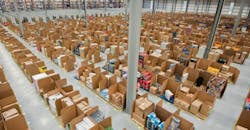Amazon Expands Delivery Trial That Could Hurt FedEx, UPS
Amazon.com Inc. is expanding a service launched to make more groceries, cleaning supplies and other products available for quick delivery directly from merchants without overwhelming the e-commerce giant’s warehouses with additional inventory, according to documents reviewed by Bloomberg.
The trial pushes Amazon’s logistical reach beyond its own facilities and into those of its merchants, encroaching on services of long-time delivery partners United Parcel Service Inc. and FedEx Corp. Amazon is enticing the sellers who use the company’s online marketplace with lower delivery costs, logistics software, warehouse inspections and recommendations.
Bloomberg first reported on the trial in October, which was called “ seller flex.”Amazon will oversee pickup of packages from warehouses of third-party merchants selling goods on Amazon.com and the delivery to customers’ homes, work that is now often handled by UPS and FedEx.
Amazon could still use these couriers for delivery, but the company will decide how a package is sent instead of leaving it up to the seller. Handling more deliveries itself would give Seattle-based Amazon greater flexibility and control over the last mile to shoppers’ doorsteps, let it save money through volume discounts and help avoid congestion in its warehouses by keeping merchandise in the outside sellers’ own facilities.
Amazon is recruiting more sellers and has changed the name to FBA Onsite, according to documents reviewed by Bloomberg, associating the program with its popular logistics service Fulfillment By Amazon that launched in 2006. Amazon is telling merchants they can keep goods in their own warehouses and still participate in programs such as “Subscribe and Save,” a household goods replenishment service that offers customers discounts on frequently purchased items, and “Small and Light,” a free delivery service of products that are cheap to ship due to their size. Merchants previously had to send goods to Amazon facilities and pay additional fees to participate in these programs. The company declined to comment.
Delivery Options
FBA Onsite is Amazon’s latest attempt to increase inventory, shorten delivery times and reduce costs. The company already has built a network of centers around the country, where packages are sorted by zip code and trucked to post offices, with the U.S. Postal Service handling the final mile of delivery. It launched Amazon Flex, which uses independent contractors driving their own vehicles to deliver packages from Amazon shipping hubs, guided by a smartphone app. Prime Now offers a limited assortment of products, such as phone chargers and bottled water, in as little as an hour to shoppers in many cities.
Fulfillment By Amazon lets merchants send inventory to Amazon warehouses and pay Amazon to handle storage, packing and delivery. About half of the items sold on Amazon come from independent merchants who pay the company commissions on each sale. Many of those merchants pay additional fees to have Amazon handle logistics because it makes their products eligible for free two-day shipping through the Amazon Prime membership program. Many Amazon shoppers filter product searches on the site to only show products that are Prime eligible, so Fulfillment By Amazon helps these merchant boost sales.
The centralized approach of Fulfillment By Amazon gives the online retailer greater control over the inventory on its site, enabling it to guarantee quick delivery without having to rely on merchant partners to fulfill the pledge. But it adds costs because goods have to flow from merchants to Amazon to customers rather than from merchants to customers directly.
Attractive to Merchants
The popularity of the service strained Amazon’s capacity, especially during the busy holiday shopping season, driving up costs. Amazon in 2016 tried to relieve congestion by introducing Seller Fulfilled Prime, which let select merchants keep inventory in their own warehouses and still have their products listed on Amazon as Prime eligible.
The problem with Seller Fulfilled Prime is that it obligated merchants to deliver items quickly, driving up their costs, said Chad Rubin, co-founder of Skubana, which sells e-commerce management software. FBA Onsite solves this issue because it offers shipping rates as much as 70% less than merchants would pay themselves, he said.
“FBA Onsite is an improvement to Seller Fulfilled Prime since shipping costs for merchants were so high,” Rubin said.
By Spencer Soper
